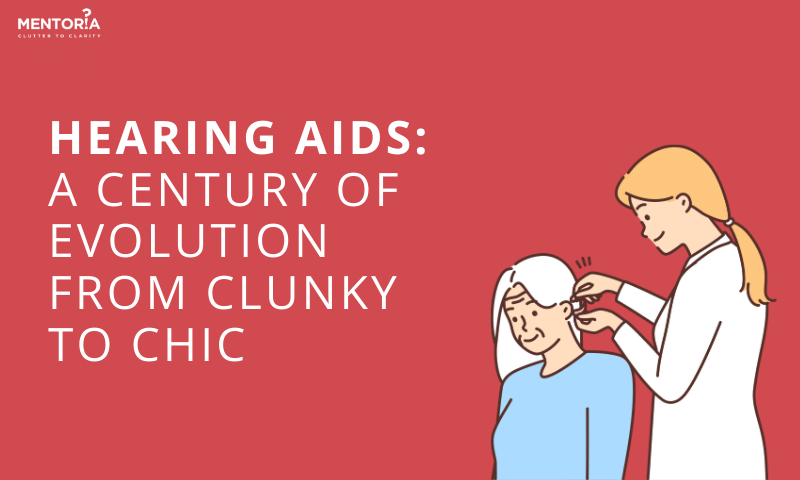Hearing Aids: A Century Of Evolution From Clunky To Chic

In a world filled with cutting-edge gadgets, it’s easy to forget the incredible journey of a humble yet transformative invention—the hearing aid. These little marvels of technology have not only improved the quality of sound but have also revolutionised the way we perceive and interact with the world around us. This journey of a hundred years is a testament to human ingenuity and our relentless pursuit of enhancing the human experience. As hearing aids have evolved, so too has the way we think about them. No longer are they seen as a sign of weakness or disability. Instead, they are seen as a way to improve quality of life and connect with the world around us.
The Remarkable Evolution Of Hearing Aids
The Humble Beginnings Of Ear Trumpets
Our journey begins in the 17th century when hearing aids were far from sleek and discreet. Back then, people used ear trumpets, which were essentially funnel-shaped devices made of various materials, such as wood, brass, or silver. These contraptions were held up to the ear, capturing sound waves and funnelling them into the ear canal.
While they were far from perfect and somewhat conspicuous, ear trumpets marked the first step towards assisting those with hearing loss. Can you imagine strolling down the street today with a giant metal horn attached to your ear? Yikes!
The Carbon Microphone Era
Fast forward to the late 19th century, and technology started to catch up with the needs of the hearing-impaired. The carbon microphone was invented, which paved the way for electrical hearing aids. These devices used carbon granules to amplify sound, a significant improvement over ear trumpets.
However, they were still relatively bulky and not particularly stylish. You wouldn’t see folks casually donning carbon microphones while out for a stroll, but they were undoubtedly a step in the right direction.
The Miniaturisation Revolution
The mid-20th century marked a turning point in hearing aid evolution. Miniaturisation became the buzzword as hearing aids gradually transformed from conspicuous contraptions into more manageable devices. Transistor technology played a crucial role here, making hearing aids smaller, more efficient, and less conspicuous.
Imagine a hearing aid that could fit in the palm of your hand! These early transistor-based models started to gain popularity, although they still had wires and were noticeable to some extent. Nevertheless, it was a huge leap forward for the hearing-impaired community.
The Digital Age Dawns
The 21st century ushered in a new era for hearing aids, the digital age. Digital signal processing allowed for more precise amplification and customization of sound. This meant that hearing aids could be tailored to the specific needs of each individual, offering a more natural listening experience.
Moreover, digital hearing aids started to embrace connectivity, allowing users to wirelessly connect to smartphones and other devices. This not only made them more functional but also fashionable, as they could now pass as trendy Bluetooth earpieces.
The Rise Of Invisible Hearing Aids
With the advancement of digital technology, hearing aids took on a whole new level of discreteness. Invisible hearing aids, such as in-the-ear (ITE) and completely-in-the-canal (CIC) models, started to gain popularity. These devices fit snugly inside the ear canal, making them virtually invisible to the naked eye.
Invisible hearing aids not only addressed the cosmetic concerns but also improved comfort and reduced wind noise. Users no longer had to worry about clunky devices attracting attention. They could comfortably go about their daily lives without any stigma attached.
Earbuds – The Modern Hearing Aid
Now, let’s fast forward to the present day, where we find ourselves in an era of unprecedented technological innovation. It’s time to talk about a game-changer in the world of hearing aids – earbuds!
Yes, you read that right. The same earbuds that you use to listen to your favourite music and answer calls are now being transformed into powerful hearing aids. With the integration of advanced sound processing algorithms and noise-cancelling technology, these earbuds are changing the way we think about hearing assistance.
Statistics show that in 2023, approximately 466 million people worldwide suffer from disabling hearing loss. Fortunately, technology is catching up, and these numbers are on a downward trend thanks to innovative solutions like modern earbuds. A recent survey conducted by a leading hearing aid manufacturer revealed that 81% of users reported improved quality of life after using modern hearing aids. These devices don’t just amplify sound; they enhance overall well-being. The demand for hearing aids is rising, and this is creating new career opportunities in the hearing aid industry. There are many different jobs available in this field, including:
- Audiologist: An audiologist is a healthcare professional who specialises in diagnosing and treating hearing loss. They can fit and dispense hearing aids, and they also provide counselling and education to patients.
- Hearing aid dispenser: A hearing aid dispenser is a trained professional who can fit and dispense hearing aids. They do not need to be an audiologist, but they must be certified by the National Board for Certification in Hearing Instrument Sciences (NBCHIS).
- Hearing aid manufacturer: There are many companies that manufacture hearing aids. These companies employ engineers, scientists, and other professionals who develop new hearing aid technologies.
- Hearing aid retailer: Hearing aid retailers sell and dispense hearing aids. They also provide customer service and support to hearing aid users.
There are several reasons why the demand for hearing aids is rising. One reason is that the population is ageing. As people get older, they are more likely to experience hearing loss. Another reason is that noise pollution is on the rise. Exposure to loud noise can damage hearing, and this is a major cause of hearing loss in young people. Finally, advances in technology have made hearing aids more affordable and accessible than ever before.
Earbuds As Hearing Aids
So, how exactly do these earbuds double as hearing aids? Well, it’s all about the smart tech packed inside them.
- Noise Cancellation: Many modern earbuds feature active noise-cancelling technology, which can significantly reduce background noise, making it easier for users to hear conversations and sounds clearly.
- Sound Amplification: Some earbuds offer customizable amplification settings that allow users to boost specific frequencies to better suit their hearing needs.
- Connectivity: Bluetooth connectivity allows users to stream audio from their smartphones or other devices directly to their earbuds. This makes phone calls, music, and even audiobooks more accessible for those with hearing loss.
- App Integration: Hearing aid apps now exist, providing users with fine-tuned control over their hearing experience. These apps allow for personalised adjustments and even remote consultations with audiologists.
The Future Of Hearing Aids
According to the World Health Organization (WHO), by 2050, over 700 million people are projected to have disabling hearing loss. The good news is that technology advancements are making hearing aids more accessible and effective. As we stand on the brink of the future, it’s exciting to speculate about what lies ahead for hearing aids. Here are some potential developments we can look forward to:
- Artificial Intelligence: AI will continue to play a significant role in hearing aids. These devices will become smarter, adapting to different environments and learning from users’ preferences.
- Augmented Reality: AR could revolutionise the way we interact with the world. Hearing aids may integrate seamlessly with AR glasses, providing real-time translations, captions, and other enhancements.
- Health Monitoring: Future hearing aids might not only assist with hearing but also monitor vital health signs, such as heart rate and blood pressure.
- Tinnitus Management: Advanced tinnitus management solutions are in development, offering relief to those who suffer from persistent ringing in the ears.
Embrace The Future Of Hearing Aids With Mentoria
The journey of hearing aids from the humble ear trumpet to the sleek earbuds of today is a testament to human innovation and progress. As technology continues to advance, hearing aid users can look forward to even more sophisticated and user-friendly devices that seamlessly integrate with their lifestyles.
Mentoria, a leading career and educational guidance platform, is dedicated to supporting individuals interested in audiology, hearing healthcare, and related fields. Our experienced mentors can help you explore career paths in audiology, hearing aid technology, and healthcare, providing valuable insights and guidance to kickstart your journey in this evolving field.
So, whether you’re considering a career in audiology or simply want to stay informed about the latest advancements in hearing aid technology, Mentoria is here to assist you. Embrace the future of hearing aids and be part of an exciting era of innovation and accessibility.









